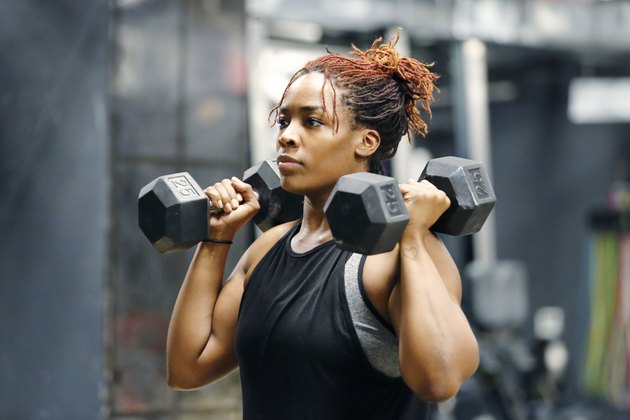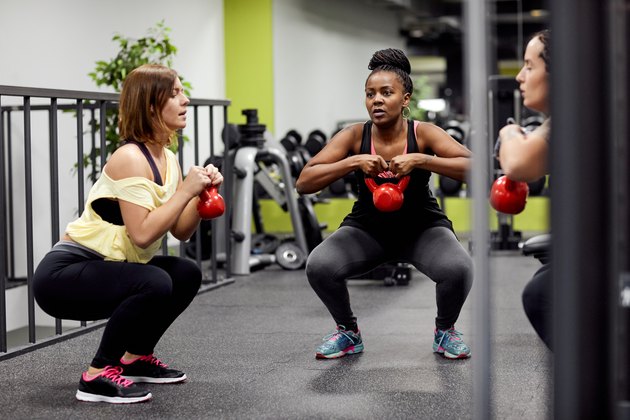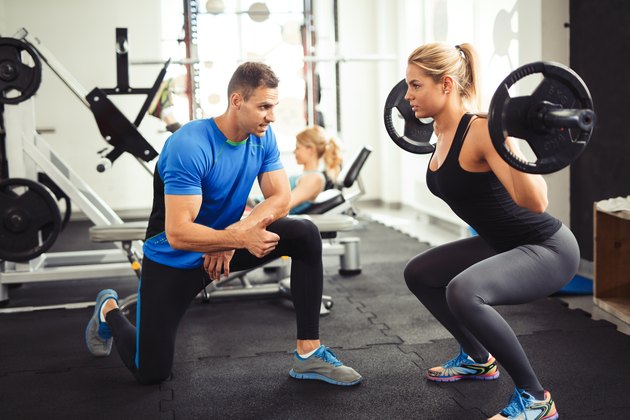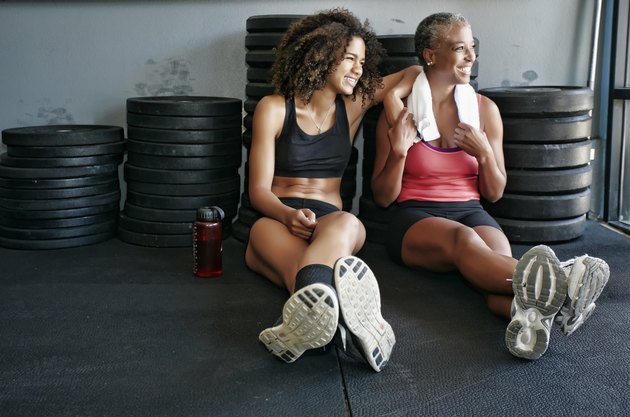It
used to be that the weight room of most gyms was filled solely with men
(and the occasional brave female). But recently, women have begun to skew that ratio
more in their favor. And with good reason! There are so many great
reasons to add strength training to your fitness routine, regardless of
your gender, but specifically for women.

But
if you're a little unsure of where to start, here's a beginners guide
to strength training for women, so you can strut into the weight room
with confidence.
Benefits of Strength Training for Women
While there are a host of benefits of strength training for both men and women, strength training is especially beneficial for women.
1. Improving Bone Health: Strength training is one of your best strategies for keeping your bones healthy as you age, according to a 2009 review in Clinical Cases in Mineral and Bone Metabolism.
"Simply
the pushing and pulling of the muscles against your skeleton stimulates
osteoblast activity, which are the cells of the bone that create bone
growth," says Holly Perkins, CSCS, author of Lift to Get Lean.
For
women, shoring up bone strength is especially important. In fact,
approximately 80 percent of the estimated 10 million Americans currently
living with osteoporosis are women, and roughly half the women over the
age of 50 will break a bone because of osteoporosis, according to the National Osteoporosis Foundation.

2. Maintaining Muscle Mass:
Women start to lose muscle mass around the age of 40. If you don't do
something about it, you'll keep losing muscle every decade until roughly
50 percent is gone by your 80th birthday, says a 2014 review published
in Current Opinion in Rheumatology. The review also cites loss of muscle as one of the major reasons people lose independence as they age.
3. Burning More Calories:
If it's too soon to think about that, you might be interested to know
that adding muscle to your frame can help you burn more fat over time
(provided you follow a healthy diet as well). "The more muscle mass you
have, the more calories you burn throughout the day," says Jennifer Cohen, author of Strong Is the New Skinny.
Just how many more calories? A 2010 study published in the American Journal of Clinical Nutrition
reveals that one pound of muscle burns roughly six calories per day,
whereas one pound of fat burns only two. This difference may appear
minor, but every little bit adds up.
"What
strength training does is it helps you beef up the amount of muscle you
have on your body, and then that muscle will help burn off the body
fat," Perkins says. (Just keep in mind that no amount of muscle will
compensate for a poor diet.)
4. Boosting Confidence:
But the benefits of strength training don't stop with the physical:
"We've found that [strength training] is a really fantastic way to build
confidence," says Jen Comas, NASM personal trainer and co-founder of Girls Gone Strong.
"When
we can get women focused on strength training, it gives them a better
feel for what else they're able to accomplish in their life." In other
words: Strength in the gym often translates into strength outside of the
gym as well.
Will I Get Bulky If I Lift Weights?
Now, if you're worried that strength training will make you "bulky" or "manly," know that women in general lack the hormone levels needed to pack on muscle. "I've yet to see any woman become an Arnold Schwarzenegger by lifting weights," Cohen says.
That
said, the definition of "bulky" will be different from one woman to
another and lifting weights will build muscle. Just how much muscle and
where you'll see it the most depends on your routine and genetics. If
you're genuinely worried about adding muscle, start with whatever weight
you feel comfortable with and increase from there.
"We
really let the client guide themselves with that and try to be
respectful of their concerns," Comas says, "rather than our old way,
which used to be to dismiss them and try to rush someone into lifting
heavy."

How to Get Started With Strength Training
Starting a new routine
or activity can be exciting — and confusing. "Often times we see women
who are really excited, they want to get started, but they get to the
gym and they have no idea what to do," Comas says. "They find themselves
just kind of wandering around, which is not a good headspace to be in."
The best way to avoid aimless wandering is to get your hands on a strength training program
or work one-on-one with a certified personal trainer. Start by asking
for recommendations from friends, family and colleagues, and go from
there.
If
you're not ready for a full-fledged program just yet, start by
incorporating five to 10 minutes of strength training into your routine
once or twice a week, Cohen says. You could try push-ups (on your knees
or incline is just fine), body-weight squats, lunges and anything else
you can think of (just make sure you look up or ask about proper form
before trying anything completely new).
"If
you get intimidated or overwhelmed, just do something to begin your
journey," Perkins says. "Over time, you'll learn ways to do it better."
Best Strength-Training Exercises for Women
In
general, women are capable of following any training program designed
for men (and vice versa), and according to Comas, any good exercise
program will include exercises that cover the basic movement patterns:
- Squat
- Lunge
- Hinge (ex. deadlift)
- Upper-body pull (ex. bent-over row)
- Upper-body push (ex. push-up)
- Twist (ex. cable cross-overs)
- Carry (ex. Farmer's carry)
That
said, it can be helpful for women to place extra focus on their
posterior chain, or the muscles that make-up the back of the body (i.e.
glutes, hamstrings, lats). "[Women] tend to be wider at the hips, so to
make sure we keep our bodies balanced and knees healthy, we want to do
work for the glutes and hamstrings," Comas says. (Think: glute bridges,
Romanian deadlifts and hamstring curls.)
Also,
be sure not to neglect your upper-body. "Women tend to focus on their
lower half," Cohen says. "In reality, if [women] focused on their
upper-body more, they would look leaner, because the first thing your
eye goes to is the shoulders, arms and neck."
In addition to the visual appeal of having a strong upper half, putting more attention into the back and shoulder muscles in particular will help counteract all the hours we spend sitting at a computer during the day.
"We're
constantly hunched over and it's terrible for our posture and our
spine," Cohen says. Exercises like overhead presses, lat pulldowns,
lateral raises and pull-ups (modified is fine) are just a few great
posture-strengthening exercises to look for in any program.

How to Not Be Intimidated in the Weight Room
It's not uncommon for women to feel intimidated
when they enter the weight room for the first time. If this is you,
you're not alone. "Most people don't really know what they're doing,"
Perkins says, "so that really levels the playing field." Still, there
are ways to feel a little more comfortable when you do step out on the
gym floor.
1. Go During Slower Times:
Most gyms have a pre- and post-work rush, and can get pretty busy. If
you can avoid the crowds, you might feel less intimidated, Comas says.
2. Wear Something Comfortable:
Don't wear something just because you think it's what you're supposed
to wear. After all, nothing is worse than trying to work out when you
don't feel comfortable in your own clothes. And keep in mind that what
feels comfortable will be different for every person. "Some people might
feel their best in tights and a crop top, while other people might want
to wear a hat and baggy sweats," Comas says.
3. Start With One Set of Weights: Another great tactic is to find a routine that only requires one set of weights to complete.
This way, you can grab your dumbbells at the beginning of your workout
and find a quiet corner to do your routine. "That's a good way to get
acclimated to the environment without having to hunt for equipment,"
Comas notes.
4. Take Baby Steps:
If you can't work up the courage to get to the gym in the first place,
take baby steps. One week, put on your workout clothes and do a workout at home.
The next week, put on your workout clothes and drive to the gym —
without going inside. Take it one step at a time and work up to that day
when you finally go in and do your first workout. "It sounds so
trivial, but it can be incredibly impactful," Comas says.
5. Find a Gym Buddy: If you can, recruit a friend to join you. "Everything is less scary if you've got a friend or some type of support system with you," Comas says.
Finally,
know that you have every right to be in the weight room. If anyone ever
makes you feel uncomfortable, or like you don't belong in that space,
don't be afraid to talk to management, Comas says.
Source Click here
Source Click here
Comments
Post a Comment